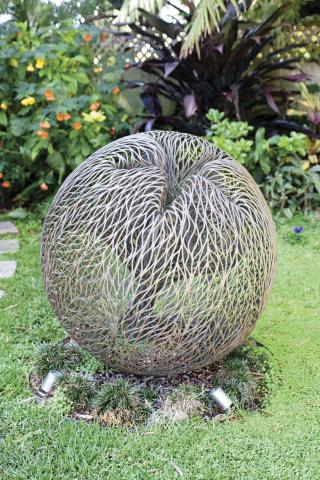CALYX, 2002
Bronwyn Oliver
copper with concrete base
104.0 cm height (excluding base)
Commissioned by the current owners
Private collection, Sydney
One of Australia's most highly regarded contemporary sculptors, Bronwyn Oliver remains celebrated for her extraordinary ability to produce meticulously articulated works of immense beauty and grace which unite timeless, organic forms of the natural world with the abstract logic of geometry. Simple yet complicated, fragile yet strong, eccentric though at the same time oddly straightforward, her delicately woven copper and bronze sculptures such as Calyx 2002 universally surprise and inspire- beguiling both the eye and mind through their enigmatic presence. With their tactility and anatomical physicality, such intricately executed forms moreover inevitably elicit a temptation to touch - the sensual, prehistorically-scaled versions of natural phenomena thus reminding us that the world is a corporeal place.
In the same vein as her commanding two-metre high Grandiflora (bud) nestled among Agapanthus bushes in the Royal Botanic Gardens, or the accompanying work Palm which assimilates itself in the flora nearby, Calyx was specifically destined for an outdoors setting and thus, although an oversized version of a smaller specimen, appears intrinsic to its natural surrounds. Alluding to the collective unit of sepals (the green structure of a flower which lies beneath the more conspicuous petals), the title is typically apt and sophisticated, which - together with an astonishing clarity of vision and execution- imparts a wholeness, an authority and an overwhelming sense of inevitability, as though the piece had always existed. Such ease or resolution nevertheless belies the punishing, labour-intensive process to which Oliver was so passionately committed - the painstakingly manipulated twistings and welds of pliant copper wire here creating an especially intricate labyrinth or 'weave' (the microstructure of her organic sculptural form which gradually becomes more open and geometric to allow light to permeate and exaggerate its optical aspect).
As Amanda Rowell muses in her introduction to Oliver's exhibition at Roslyn Oxley Gallery in September 2004, '...the microcosmic, complex surface of an Oliver sculpture is an interface between the macroform of its overall shape and the internal cavity or void where the sculpture breathes. The ease of connection between these three formal aspects of her works, along with their gently mimetic character - as alluded by their titles - constitute their elegance and simple pleasure...'1
1.'Bronwyn Oliver 2004', 9 September 2004, see http://www.roslynoxley9.com.au/news/ releases/2004/09/08/80/
VERONICA ANGELATOS
